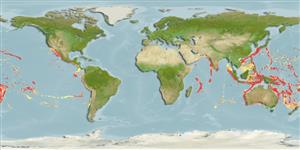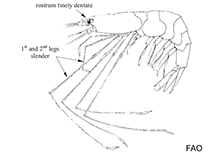Nematocarcinus gracilis Bate, 1888
| Native range | All suitable habitat | Point map | Year 2050 |

|
| This map was computer-generated and has not yet been reviewed. |
| Nematocarcinus gracilis AquaMaps Data sources: GBIF OBIS |
Upload your photos
Google image | No image available for this species;
drawing shows typical species in Nematocarcinidae.
Google image | No image available for this species;
drawing shows typical species in Nematocarcinidae.
Classification / Names Common names | Synonyms | CoL | ITIS | WoRMS
Malacostraca | Decapoda | Nematocarcinidae
Environment: milieu / climate zone / depth range / distribution range Ecology
Benthopelagic; depth range 200 - 1475 m (Ref. 96667). Deep-water; 33°N - 40°S, 54°E - 71°W
Distribution Countries | FAO areas | Ecosystems | Occurrences | Introductions
Indo-Pacific.
Length at first maturity / Size / Weight / Age
Maturity: Lm ? range ? - ? cm
Typically found near the sea floor in deep-seas. Its characteristic 3 pairs of extremely long, stilt-like pereiopods suggest its ability to walk on soft sediments. An opportunistic feeder, relying on phototrophically derived organic matter. Its feeding strategy may be assumed to be similar with its congener, N. exilis, a scavenger and predator that feeds mainly on fish remains and slow-moving benthic organisms. Shown to produce oval eggs (0.5 to 0.65 mm length) and may possibly achieve several reproductive outputs in its relatively long lifespan of 2 to 3 years (Ref. 97382).
Life cycle and mating behavior Maturity | Reproduction | Spawning | Eggs | Fecundity | Larvae
Members of the order Decapoda are mostly gonochoric. Mating behavior: Precopulatory courtship ritual is common (through olfactory and tactile cues); usually indirect sperm transfer.
Main reference
References | Coordinator | Collaborators
Poupin, J. 1998. (Ref. 75706)
IUCN Red List Status (Ref. 130435)
CITES status (Ref. 108899)
Not Evaluated
CMS (Ref. 116361)
Not Evaluated
Threat to humans
Human uses
| FishSource |
Tools
More information
Age/Size
Growth
Length-weight
Length-length
Morphology
Larvae
Abundance
Growth
Length-weight
Length-length
Morphology
Larvae
Abundance
Internet sources
BHL | BOLD Systems | CISTI | DiscoverLife | FAO(Publication : search) | Fishipedia | GenBank (genome, nucleotide) | GloBI | Gomexsi | Google Books | Google Scholar | Google | PubMed | Tree of Life | Wikipedia (Go, Search) | Zoological Record
Estimates based on models
Preferred temperature
(Ref. 115969): 6 - 12.8, mean 8.3 (based on 423 cells).
Price category
(Ref. 80766):
Unknown.



